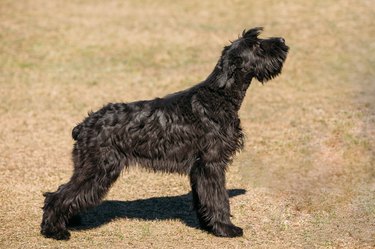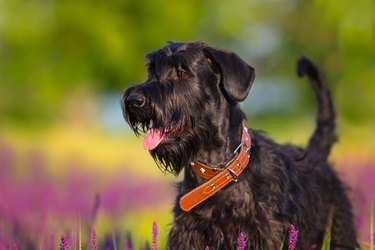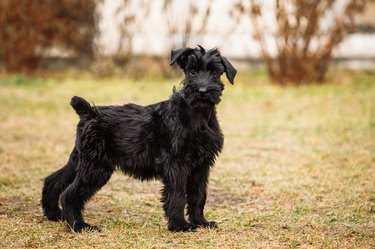
The giant schnauzer is a loyal and intelligent companion and guard dog. Bred in the mid-1800s in the Bavarian Alps, the breed was originally used to help drive cattle. They have since been used in Europe and other locations as police and military dogs. The giant schnauzer is hypoallergenic, making the breed an excellent choice for dog lovers who want a larger breed without the dander and shedding.
Giant schnauzer characteristics
Video of the Day
Giant schnauzers are a part of the American Kennel Club's working group. They are a distinct breed but have a very similar appearance as the standard schnauzer. They have a dense, wiry coat that is black or pepper and salt in color. They have distinctive eyebrows and beards. Most dogs will have their ears cropped and tail docked.
Video of the Day
The giant schnauzer size for males is 25.5 to 27.5 inches tall at the withers. They weigh between 60 and 85 pounds. Females are smaller, measuring only 23.5 to 25.5 inches tall. The giant schnauzer weight for a female dog is between 55 to 75 pounds.
Giant schnauzer temperament & training
Breed is not a reliable indicator of personality, however, the giant schnauzer dog is known to be loyal and alert. The breed is very trainable and reliable. They also tend to be territorial, watchful, and composed, qualities that help make them an excellent guard or watchdog. Giant schnauzers prefer companionship with their human if possible, or with another dog in the household.
They are easy to train with plenty of positive reinforcement. As a working dog, the giant schnauzer needs a job. Consider a sport such as agility or herding or simply work with him daily on obedience or fetching a ball. Due to the large schnauzer size and territorial nature, socializing dogs when they are young and teaching basic obedience are incredibly important.
Giant schnauzer grooming
Giant schnauzers have a wiry coat with a soft undercoat. Shedding is minimal, but they still need to be brushed at least once per week, but daily brushing is ideal. The dog's coat does need to be clipped regularly, especially his face. You can purchase clippers and do this on your own or take the dog to a groomer. Bathe as needed and before giving the dog a haircut.

You will need to wipe your giant schnauzer's face and beard frequently as it often gets wet and dirty as he eats and drinks. Keep his nails trimmed as needed and check his ears regularly. Regular teeth brushing with dog toothpaste is also beneficial for the giant schnauzer.
Giant schnauzer exercise & health
Despite his composed appearance, the giant schnauzer is very high energy. Make sure to take the dog out for a long walk each day or consider other activities such as playing with other dogs or fetch in the yard. You can also take the dog out with you for your workout whether you plan to run, bike, or swim.
The average giant schnauzer life span is 12 to 15 years. The breed is generally healthy. Some health conditions to watch out for include autoimmune thyroiditis, eye disease, and hip dysplasia. When selecting a dog, make sure to purchase from a reputable breeder that completes health testing for the parents and puppies.
Giant schnauzer puppies

Giant schnauzers grow quickly during the first year of their life, but they don't reach their full size until they are 16 to 19 months old. At three months of age, a female giant schnauzer puppy will usually weigh between 21.3 and 27.9 pounds. By the time she is six months, her weight will increase to 39.6 to 52.1 pounds.
Male giant schnauzers weigh an average of 23 and 36.6 pounds when they are three months old. At six months, they grow to between 42.7 and 68 pounds.
- Belpatt: Weight of Giant Schnauzer
- American Kennel Club: Giant Schnauzer
- American Kennel Club: Hypoallergenic Dogs
- American Kennel Club: 10 Things To Know About Giant Schnauzers
- American Kennel Club
- American Kennel Club: Hypoallergenic Dogs
- American Kennel Club: 10 Things To Know About Giant Schnauzers
- Belpatt: Weight of Giant Schnauzer